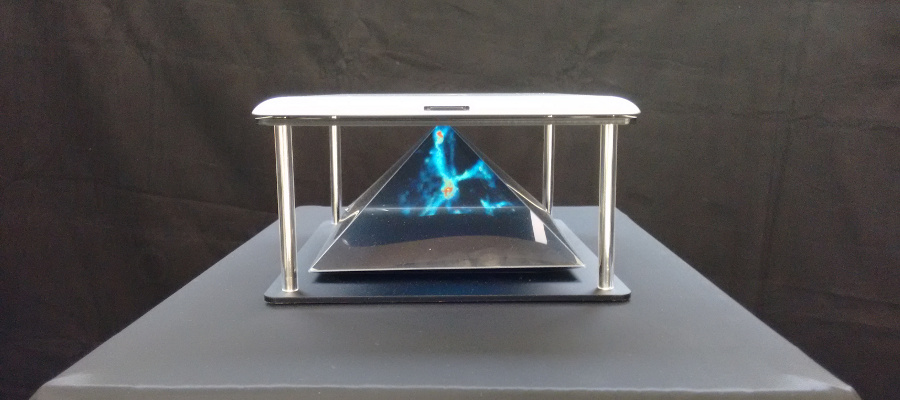Hologalaxies@AIP
Start one of the videos with a smartphone or tablet, put a foil pyramide as a hologram projector in die center and watch galaxies, the Milky Way or our Sun as a hologram!
With computer simulations of the Universe, researchers study the formation of galaxies. Here zou can see the gas distribution in a galaxy from such a computer simulation.
This video shows the distribution of dark matter in and around the same galaxy. Dark matter provides the largest part of a galaxy's mass.
The Milky Way is a barred spiral galaxy with an elongated region in the center where the density of stars is incresed. With observational data from the Gaia satellite and other sky surveys in infrared and optical light, the bar becomes directly visible in this video as a bright area with high stellar density.
The movement of some stars in the Milky Way. The Gaia satellite measures not only the positions but also the velocities of stars within the Milky Way. This makes it possible to simulate the orbits on which the stars move through their galaxy.
Time-lapse movie of the Sun in ultraviolet and optical light. Especially in ultraviolet light, you can see how the Sun's surface bubbles and eruptions occur.
Collision and merging of two spiral galaxies, gas density from a computer simulation. That's an example what it could look like when our Milky Way and the Andromeda galaxy meet in the distant future.
Galaxies
Galaxies are huge collections of stars, gas nebulae, dust and dark matter in the Universe. They took billions of years to form and to evolve to their present state. Astronomers use computers to simulate their formation. Studying time-lapse visualisations of the evolving Universe since the big bang, they strive to decipher the building blocks of the cosmos and to comprehend its overall nature.
The computer simulations exhibit countless different types of galaxy shapes and structures, of individual galaxies and galaxy mergers. The structure formation is driven by the gravitational force of matter - where next to luminous „normal“ matter especially the mysterious dark matter plays a crucial role.
The Milky Way, visible as a nebulous band in a dark night sky, is also a galaxy, and the Sun is one of its 400 billion stars. In an important galactic event about 10 billion years in the future, our home galaxy will collide and merge with the neighboring Andromeda galaxy.
Discover even more galaxies from computer simulations here:
{$ service.movie.desc $}
Build your own hologram projector
It takes only a couple of minutes to build a simple mini projector for your smartphone or tablet.
(Nearly) all videos in one (mp4):


